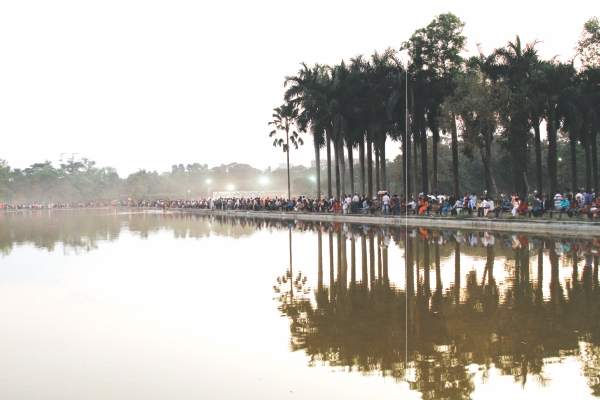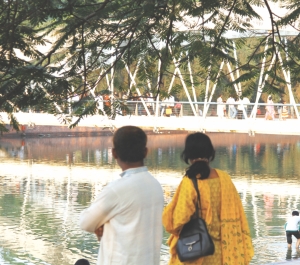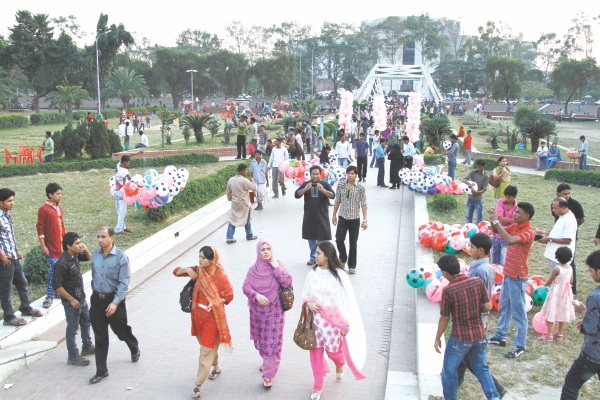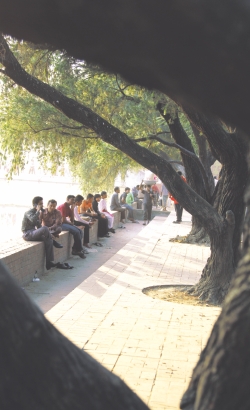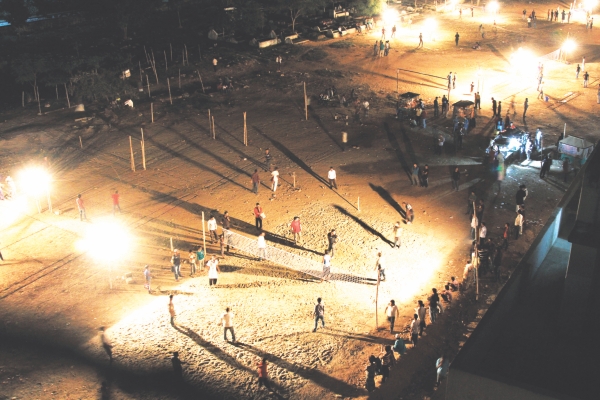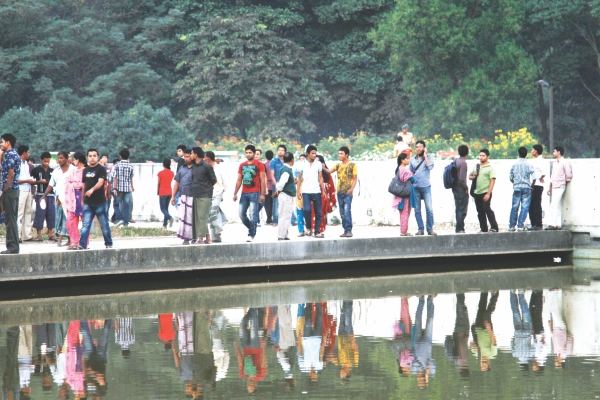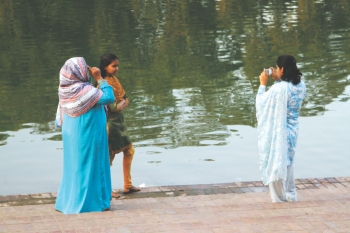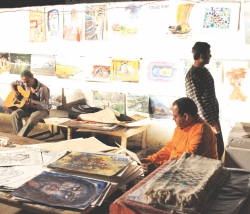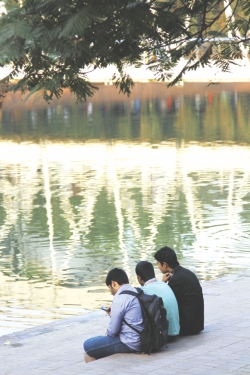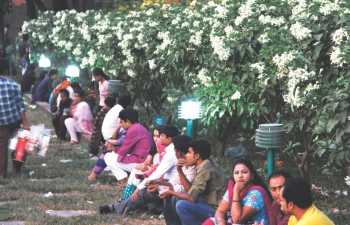| Home - Back Issues - The Team - Contact Us |
 |
| Volume 10 |Issue 46 | December 09, 2011 | |
|
|
Cover Story
Rethinking, Remapping and Reclaiming Space As a consequence of urbanisation, urban sprawl and illegal land grabbing, public open spaces have all but vanished in Dhaka city. The few remaining spaces at the metropolitan and community levels are in lamentable conditions. Under the circumstances, the government, urban planners and the public should realise the value of our public open spaces and take appropriate steps to create new spaces and conserve existing ones. Sushmita S Preetha The Urban Condition Over the past two decades, rapid urbanisation, unplanned city growth and increasing concentration of population in the city have put tremendous pressure on existing open spaces. The image of the concrete jungle has become the defining image of the once lush and serene Dhaka city.
“Where have all the open spaces gone?” laments Zeba Khondker, like millions of Dhaka inhabitants. “This city doesn't give us a space to breathe, to interact with people outside of our own confined lives, to escape the madness of the bustling city,” she says. Having spent her childhood in Dhaka University, one of the few remaining areas in the city with an abundance of green open spaces, she feels suffocated by the concrete walls that surround her and her grandchildren in their cramped apartment in Muhammadpur. Adrita, 4, and Adnan, 8, have no place to play chhoa-chhowi or ekka-dokka. Their father and Zeba's son, Shaker, a diabetic patient, is forced to exercise in the house. “I know it sounds ridiculous, but I actually walk in the house. We have rearranged the furniture in such a way that I can make rounds around the house every day. It's not really possible to walk on the busy streets of Dhaka,” he explains. Domestic workers, Nilufar and Rima, who work in a house in Lalmatia, say they have no place to go on their off-days. “We get a half day-leave on Friday, but where will we go? We can't afford to go to markets or coffee shops like our madams,” says Rima. They have visited Dhanmondi Lake and Chandrima Udyan a few times, but, for them, the trip is too expensive and can only be made once a month at most. For the not-so-well-off populace of Dhaka, who cannot take refuge in air-conditioned shopping malls or exclusive lounges, Dhaka offers very few recreational spaces that are affordable, accessible and approachable. Dhaka dwellers are constantly reminded of the physical limitations of their beloved city. They seek a refreshing contrast to the dreary and imposing structures of steel and concrete. A handful of public open spaces at the metropolitan level and small parks, fields or water bodies at the community level scattered all throughout the city provide much needed respite to Dhakaites. All agree, however, that there is a severe shortage in the amount of allocated space and grave limitations in the way these spaces are maintained. Single place, Multiple Spaces
It is not necessary that these spaces provide the same functions to all its users; while some may be there to eat phuchka with their friends, others may be there to earn a living from selling snacks. A father might use a park for his morning walk, while his son uses it as a dating spot. In Chandrima Udyan, on any given Friday, one can find a wide range of people of various age and wage groups: small children playing cricket as their mothers chat with each other about their daily lives, lovers trying to get a little privacy amid the madding crowd, a family of four from the outskirts of the city on a picnic, a woman selling flashy plastic flowers, or young boys yelling “cha or coffee” to convince the passer-by to buy a cup. All of these users use the space for their own individual ends without compromising its collective nature.
The community spaces at the local level, too, serve multiple purposes. The Iraqi Gorosthan in Azimpur, for example, is like the Room of Requirement in Hogwarts. It's not just a graveyard: it's used as a playfield, vegetable market, parking spot, prayer and qurbani sites at different times by the various inhabitants of the locality. Even though the space is maintained by the Bangladeshi-Iraqi community living in that area, it is accessible to everyone. Given the potentially fluid nature of these public spaces, disparate groups may and often do have conflicting interests over the right of occupation and control of these places. Shabnam Rahman, for instance, is furious that the playground near her house has been taken over by local boys. “We can no longer use what used to be common public space; the local boys insist it's a cricket ground, and we cannot send our kids to play or conduct evening walks there,” she says. As an inhabitant of the area, she feels she has legitimate claims over the space. The boys, however, all between the ages 14-19, think that the playground was built for playing sports not for leisure activities. “Look what they've done to the Kalabagan field. Now it's become a market instead of a sports field,” says Shiraj, who plays cricket every afternoon in the field. In some ways, both parties are right – Shabnam needs an open space for her children and herself, while the boys, too, need an outlet for their sporting activities.
There are inevitable conflicts about what uses and activities are acceptable in a given public space, who has a greater right over its occupation and who should control these spaces. Public spaces belong to the government, and by default, the public. But in the absence of direct government regulations (or the implementation of these regulations), who gets to decide the optimal use of these spaces? The “public” is not a homogenous category, and different interest groups may have different conceptions of what a given public space should be. Sometimes, the war over public space is fought in decidedly classed terms. As architect and writer Himanshu Burte argues, “In recent times, new citizens' groups from the middle and upper classes of society have emerged in the city, effectively laying claim to public space as their space, and insisting on the removal of all those who would occupy it for functions which urban traditions have sanctioned but the law has not.” The so-called-encroachment of public spaces by hawkers, beggars, street vendors or the homeless is often criticised by the middle and upper classes, who believe there should be strict regulations limiting or restricting their access to these places. This has resulted in the exclusion of the underprivileged from these places and in their exploitation by other powerful actors (like the police who collect a bribe of 200 taka from each vendor in Suhrawardy).
But should all actors have an equal claim over these spaces? “For me, the answer seems obvious enough – a resounding yes – till I think about the questionable practices some users partake in, especially in places like Suhrowardy Udyan. We must draw a line somewhere,” says Shahjahan Bhuiyan, a student of Dhaka University. He points out that the Udyan, the site of the historic 7th March Declaration, is now a madhouse – a den for shady activities, including drug dealing, drug use and prostitution. As a result, many people, especially women and families with children, are afraid to enter the premises in the evenings. They think it's deplorable the way people are misusing such a historic place and demand that some regulations and safety measures be put in place. Some, however, disagree. As Mamoon Hossain a young professional argues: “Why should we try and impose our middle class values of what is right and wrong on other people? If they want to smoke weed, why shouldn't there be a space in Dhaka that allows them to do that?” Perhaps Hossain makes a relevant point; but how then do we reconcile the freedom of choice of the weed smokers with that of young college girls who feel threatened by their presence?
There is no objective or clear-cut solution to these contentious arguments over space. However, the way we answer questions about who gets to define a given public space and establish claims over it has serious implications for the way we envision citizenship of this city. Gendered Spaces
Despite an increasing number of women in the workplace and on the streets, the public open spaces, whether at the metropolitan or community level, still remain predominantly male arenas. Women are increasingly using these spaces in a number of different ways, but their visibility is significantly less than that of men. Even when women are present in their spaces, their public conduct is regulated by established patriarchal norms and values. A woman must be on the guard constantly, lest she be identified as a 'bad' woman. Her mobility, even when she is outside of the confines of her house, is severely restricted. Spaces at the community level, too, are gendered. There are very few spaces in the city that welcome women playing sports in public or hanging out with male friends after dark. Often, it's unsafe for women to venture into many of these male spaces alone. Even in broad daylight, there is no guarantee that a single woman will not be gawked at, teased or harassed. These gender insensitive practices in the open public spaces reflect the larger problems in society in regards to women's unequal access, mobility and power.
Mapping the Contours of Urban Open Space The government has made almost no attempts to create new spaces in the city to cater to the needs of its ever-growing population; in fact, different regimes at different times have handed over vast amounts of public lands to different institutions and private individuals. “What new spaces have we created since independence?” asks urban planner, Fazle Reja Sumon from Bangladesh Institute of Planners. He highlights that some remarkable public places in Dhaka are now built up areas. Many spaces in residential areas like Gulshan, Uttara or Mirpur are now being sold as plots to or illegally occupied by private developers. Professor Farida Nilufar points out that even the large parks of Dhaka are in danger of being encroached. For instance, an International Conference Centre has been built for NAM Summit in Chandrima Udyan, a tennis complex in Ramna Park, and Bangabandhu memorial in Suhrawardy Udyan, replacing large sections of open green spaces that function as the lungs of the city. In 2007, the government handed over a large chunk of the 64 acre ground of Suhrawardi Udyan to Dhaka Club to build a golf course, but last month the High Court declared the caretaker government's decision illegal after Bela and Ain O Shalik Kendra filed a petition in 2008. The existing spaces are in dire need of maintenance and control. There is dirt and garbage everywhere in the large parks, and no proper system or infrastructure in place to make sure that these open public spaces are kept clean, hygienic and environment-friendly. The smaller scale community spaces, too, are turned into garbage dumps with no one taking responsibility for their maintenance and protection.
Under the circumstances, the powers that be should seriously reconsider the current status of open public spaces. Ishrat Islam, professor of Urban Planning at BUET, says that the government should monitor the newly developed areas of the city to ensure that developers are following the guidelines. She also states that we should create more large scale public spaces like Ramna and Dhanmondi Park by recovering and developing our riverfronts, like in Hatirjheel.
In addition, we need to revise our Detailed Area Plan, which has been widely criticised for its anti-people and unsustainable nature. In the current DAP, there are no plans of shifting underutilised areas of Dhaka out of the city or of utilising vast restricted underutilised areas of the city. We can consider relocating places like the Cantonment or Dhaka Jail to create space in the said areas. As mentioned previously, the DAP has not set aside adequate space for parks, public spaces, water retention ponds and canals – a decision that should be immediately re-evaluated and revised. We should also monitor and prevent encroachment of valuable lands and water bodies by public and private institutions. Open spaces contribute significantly to a city inhabitant's quality of life by providing a place for recreation and relaxation in the midst of urban chaos. They create a platform for social interaction between people from a wide variety of backgrounds, and offer employment and shelter to those who do not have access to private facilities. On a broader scale, open public spaces influence the way we imagine our sense of belonging to this city. If utilised properly, these spaces can become crucial places for community-building. We, as inhabitants of this city, cannot just leave the maintenance of these spaces to the government, but also take a vested interest in the protection of cherished lands that, in the end, belong to all of us. Copyright (R) thedailystar.net 2011 |
||||||||||||||
